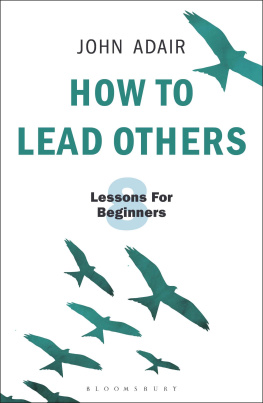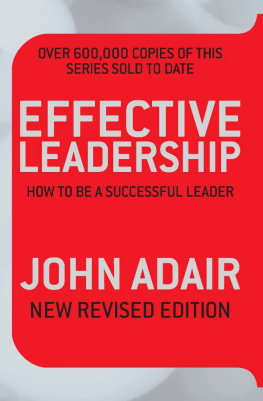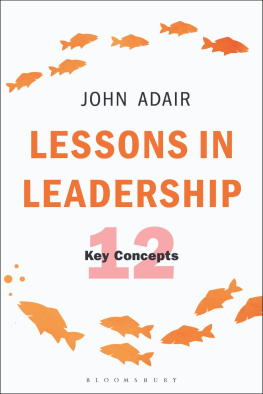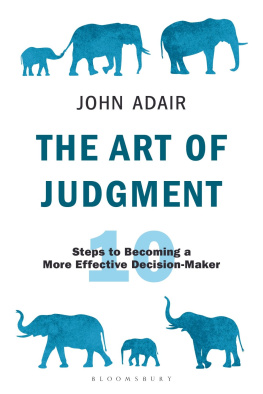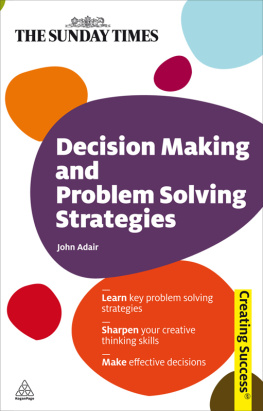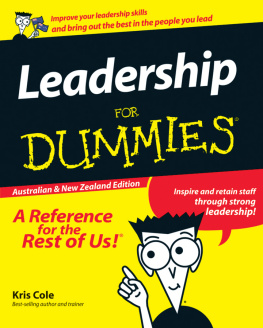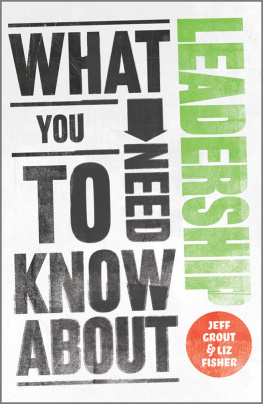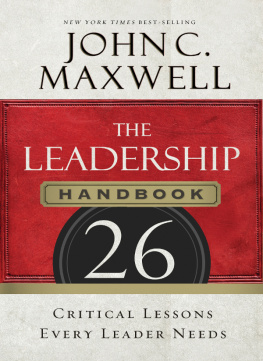
HOW TO LEAD
OTHERS
Praise for How to Lead Others
This book is a must read for anybody in a leadership role. It is entertaining, thought-provoking and clear, providing an invaluable source of guidance from a humble, acutely observant, wise and internationally-renowned scholar.
Sir Laurie Magnus, Chairman, Windsor Leadership Trust
Whatever stage youve reached in your personal leadership journey, this book is provocative, challenging and invaluable. Using a skilful blend of observation, analysis, storytelling and exercises, John Adair provokes healthy self-examination. Unlike many books on leadership, its also a cracking read.
Christopher Rodrigues CBE, Chairman, British Council
Management has Peter Drucker. But Leadership has John Adair. With his customary clear style, John Adair has created a simple, easy-to-follow text which will allow any leader from novice to those with years of experience to become more effective. Guidance is through straightforward text, powerful exercises and thorough check-lists. Its a fast read but one with all the depth you need.
Nicholas Bate, Founder, Strategic Edge;
author of 20 books on leadership
It was from Professor John Adair that I first learned that leadership is a verb. How to Lead Others is full of practical tips and exercises underpinned by Johns inimitable wisdom. Read this book reflectively as a source of inspiration and guidance for your own journey as a leader.
Georgina Noakes, Founder and Director, Brightside
John has written a practical guide to leadership brought beautifully to life by quotes drawn from many cultures and moments in time. At its heart he reinforces the critical importance for any aspiring leader to relentlessly build shared purpose, to earn respect and always be a leader for good.
Emma Fitzgerald, Managing Director
Wholesale Operations, Severn Trent plc

CONTENTS
You are not born a leader, you become one.
A PROVERB OF THE BAMILEKE PEOPLE IN WEST AFRICA
Welcome to this book! I am assuming that you have a direct personal interest in leadership. You may be already in a position which you suspect or have been told requires leadership. You may perhaps be an experienced leader, or you may be on the threshold of a career in management in which you will be expected to become a leader. In each case, leadership matters to you. Whatever your situation, this book is designed to help you to improve your leadership ability. When they call you a reaper, sharpen your scythe.
My particular focus throughout is upon you and the fledgling leader, the beginner, in the art of leading others. I can well remember personally it can be daunting to say the least to be facing the prospect of becoming leader of a team in the work environment for the first time. At least some of its members could be older and more experienced than you are. How do you acquire their respect? How do you become credible?
The way ahead
In PART ONE, Understanding Leadership, I shall share with you the story of how mankind has come to acquire a body of knowledge about leadership. The jewel in the crown of that knowledge is the discovery of the generic role of leader. That in turn stemmed from a groundbreaking discovery about the nature of all working groups.
If you can understand clearly that generic role and inscribe it on the retina of your eye you will be halfway to becoming an effective leader.
The generic role of leader can be further broken down into functions. PART TWO, Developing Your Leadership Skills, takes you into the territory of turning these functions into your personal and professional skills. This set of eight functions should be taken as indicative and open-ended, but all the most important ones are there.
How to use this book
In order to get the most from this book it is best to read it through once to get a general understanding. Then go back and work through the checklist questions and exercises. If you can persuade a friend or colleague to check your answers, so much the better.
Do not assume that you have to start from the beginning and read through to the end. The book is organized to move from the general to the more particular, from the whole to the specific part. Some people, however, prefer to learn by starting off with the particular (e.g. drills, skills or techniques) and moving to general. If you belong to this group it may be better for you to start with Part Two and work hard on that and then read Part One.
You may also, for example, prefer to complete the checklists at the end of most chapters before reading the chapter rather than afterwards. Decide your strategy for using the book now, according to your depth of interest and preferred method of learning.
The summary of key points at the end of each chapter is designed as a succinct aide-memoire, but occasionally I throw in a new idea just to see if you are still awake!
How we learn
Regardless of which approach you adopt or how carefully you read this book, you will learn nothing about leadership unless you make a conscious effort to relate the points to your real-life experience. It is essential to bear in mind that people learn by the interaction of

It is when sparks jump between these two poles the general and the actual that learning occurs. So you need both. The various case studies and examples in this book are designed to be stepping stones:

Equally, the process must work in reverse. Your practical knowledge, gleaned from both observation of actual leaders and your own practical experience, must be brought to bear in a constructively critical way on the ideas presented in this book.
For the essentials of leadership the qualities, functions and principles are the same for any field of work. I am assuming that you have sufficient creative intelligence to search for lessons about leadership in areas other than your own work sphere. To become an educated leader as well as a trained one you need a wide span of relevance. There will be a principle or general method in these examples from history or another field which is relevant to you. You have to identify that principle with my help and transfer or translate it to the context of your own field.
So read the book reflectively. Put it down occasionally and work on some incidents in your own career which are illuminated by the book, since personal reflections will illustrate leadership lessons better than any secondhand case study.
The value of having some principles, guidelines or checklists of leadership is that they will cut down the time you take to learn from experience. As Henry Ford said, By the time a man is ready to graduate from the University of Experience he is too old to work! George Bernard Shaw added that the fees you have to pay in that hard school are exceptionally high. At least I hope to spare you some of that expense!
* * * * *
As with most things in life, the more you put into reading, marking and inwardly digesting the following pages, the more you will get out of them.
Next page
